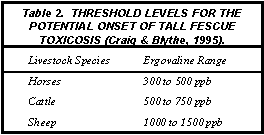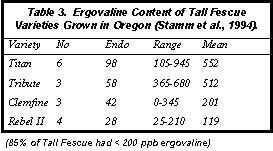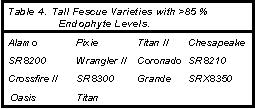| | Ergovaline concentration | Summary | Literature cited
Many grass seed crops contain an endophytic fungus (endophytes) that, in turn, increases the plants vigor, drought tolerance, resistance to predation (grazing), and ability to withstand other stresses. Plant species know to have endophytes in some varieties include tall fescue, fine fescue, hard fescue, perennial ryegrass, and bentgrass. While endophytes often improve the viability of a specific plant or plant variety, they do produce alkaloids that, when consumed by livestock, can produce toxic responses. The alkaloids produced by the endophytes are classified as ergopeptides with ergovaline generally being considered the peptide causing the toxicological problems.
Ergovaline Concentration
Ergovaline has been implicated in producing deleterious effects when consumed by livestock, particularly ruminant animals and horses. Effects on ruminants include lowered prolactin levels, increased respiration rates, long-dull-rough hair coats, lower feed intakes, lower weight gains, higher rectal temperatures, decreased heart rates, decreased skin surface temperatures of the extremities such as ears, tails and lower legs, fat necrosis, fescue foot, decreased ruminal fiber digestion and increased sensitivity to heat and cold stress conditions. Horses are considerably more sensitive to alkaloids than ruminants (Table 2) and consumption has caused reproductive problems such as agalactia, thick placentas, spontaneous abortions, dead or weak foals at birth and rebreeding problems.

In 1991, Oregon State University conducted a survey of grass seed straw harvested for livestock use. In the survey over 300 fields of straw were sampled with information gathered to ascertain the species, variety, age of stand, fertilizer profile, date of harvest, and exposure to precipitation. Mean ergovaline concentrations for tall fescue and perennial ryegrass were 86 and 214 ppb, respectively. Of the fescue fields sampled, 14% had ergovaline levels greater than 200 ppb while 42% of the perennial ryegrass contained ergovaline levels greater than 200 ppb. Furthermore, out of the 122 tall fescue fields sampled, only five had ergovaline levels that exceeded the level generally believed to cause toxicity problems. The tall fescue varieties with sample sizes of three fields or more and measurable ergovaline levels are listed in Table 3.

Identification varieties that may contain high levels of endophyte infection is important when utilizing these straws as a feed (Table 4). However, our survey results research suggests high variation in alkaloid concentration exists within varieties as well. For example, Titan tall fescue has a alkaloid concentration range from 105 to 945 ppb, with a standard deviation of + 347.7. Thus, the identification of species varieties does not tell the whole story; there is a need to identify factors that influence ergovaline concentration beyond variety and percent endophyte infected

Limited research is available regarding ergovaline levels in straw fed to beef cattle during the winter months. To date, most of the endophyte alkaloid research has focused on forages, seeds, and moderate to good quality tall fescue hays. To address this issue, we conducted two studies to evaluate the influence of ergovaline levels in straw on the nutrition, physiology, and subsequent performance of beef cattle. Two varieties of tall fescue straw (Bonanza and Titan) that were similar genetically and phenotypically, but differed in alkaloid concentrations were selected for the basal rations. The Bonanza variety was endophyte free (0 ppm ergovaline), whereas the Titan variety contained approximately 475 ppb ergovaline. The two studies, steer digestion/metabolism and yearling heifer performance study, were conducted during the 1991-92 winter with average ambient temperatures ranging from -15 to 10o Celsius.
Under the conditions of these studies, the endophyte-produced alkaloids associated with tall fescue straw did not cause health problems or reductions in animal performance. Intake and digestion were similar across all levels of alkaloids. In addition, no evidence of vasoconstriction or other physiological symptoms associated with fescue toxicosis were observed. Therefore, these studies suggest that properly supplemented low-quality straws up to 475 ppb ergovaline can be fed in winter feeding programs for growing and mid to late gestation (nonlactating) cows without depression in animal health, nutrition, or performance.
However, blood prolactin levels were decreased in the high alkaloid straw diets, indicating a possible subclinical effect. Animals exposed to greater environmental extremes (heat or cold), may in fact display health and/or performance depressions. In addition, because prolactin is an important hormone in the regulation of lactation, the lowered prolactin levels strongly suggests that these types of basal diets should not be fed to lactating cows. Further research is need to evaluate the influence of alkaloids in straw on beef cattle production in colder winter climates such as central Alberta.
Summary
Beef cattle producers in winter environments that necessitate the feeding of harvested forage are at a competitive disadvantage with other regions of North America such as the Southern US and Mexico. Reducing the costs of traditional winter management by utilizing crop residues such as grass seed straws will be important in future. Although, higher in quality than cereal grain straws, grass seed straws still need some nutritional enhancement such as chopping, grinding, pelleting and supplementation. Supplementation strategies should focus on meeting the protein needs of the animal first. Producers will have to evaluate which protein supplements are most economically viable in their region, as well as which strategy best fits their needs, nutritional calendar and management style.
Some grass species and varieties within species contain endophytes that, in turn, produce alkaloids that may be harmful if consumed by livestock. While the risk to mature nonlactating beef cattle is minimal, some precautions should be taken to reduce the potential of toxicity. First, if you have purchased a variety with a known endophyte infestation level, consider having the straw tested for alkaloid concentrations. Oregon State University can test for alkaloids in grass seed straw. Send samples to:
138 Oak Creek Building
Endophyte Service Laboratory
College of Agricultural Sciences
Oregon State University
Corvallis, OR 97331
Phone 541-737-2872
http://oregonstate.edu/endophyte-lab
In addition, always balance the rations to meet the animals' nutritional demands and dilute the straws with other roughages when you have concerns related to endophyte-produced alkaloids.
Additional research is needed, however, to fully evaluate alkaloids and feeding cattle in cold winter environments.
Literature Cited
- Albro, J. D., D. W. Weber and T. DelCurto. 1993. Comparison of whole raw soybeans, extruded soybeans or soybean meal/barley on digestive characteristics and performance of weaned beef steers consuming mature grass hay. J. Anim. Sci. 71:26.
- Chamberlain, D. and T. DelCurto. 1991. Use of grass seed residues as a winter feed resource for beef cattle. Eastern Oregon Agric. Res. Center Circ. of Info. No. 2.
- Chase, C. C. and C. A. Hibberd. 1987. Utilization of low-quality native grass hay by beef cows fed increasing quantities of corn grain. J. Anim. Sci. 65:557.
- Clanton, D. C. and D. R. Zimmerman. 1970. Symposium on pasture methods for maximum production in beef cattle: Protein and energy requirements for female beef cattle. J. Anim. Sci. 30:122.
- DelCurto, T., R. C. Cochran, D. L. Harmon, A. A. Beharka, K. A. Jacques, G. Towne and E. S. Vanzant. 1990b. Supplementation of dormant, tallgrass-prairie forage: I. Influence of varying supplemental protein and(or) energy levels on forage utilization characteristics of beef steers in confinement. J. Anim. Sci. 68:515.
- DelCurto, T., R. C. Cochran, L.R. Corah, A. A. Beharka, E.S. Vanzant and D. E. Vanzant. 1990a. Supplementation of dormant, tallgrass-prairie forage. II. Performance and forage utilization characteristics in grazing beef cattle receiving supplements of different protein concentrations. J. Anim. Sci. 68:532.
- Horney, M. R., T. DelCurto, M. M. Stamm, R. K. Barton and S. D. Brandyberry. 1996. Early-vegetative meadow hay versus alfalfa hay as a supplement for cattle consuming low-quality roughages. J. Anim. Sci. 74:1959.
- Sunvold, G. D., R. C. Cochran and E. S. Vanzant. 1991. Evaluation of wheat middlings as a supplement for beef cattle consuming dormant bluestem-range forage. J. Anim. Sci. 69:3044.
- Stamm, M. M., T. DelCurto, M. R. Horney, S. D. Grandyberry, and R. K. Barton. 1994. Influence of Alkaloid Concentration of tall fescue straw on the nutrition, physiology, and subsequent performance of beef steers. J. Anim. Sci. 72:1068.
- Turner, B., F. Conklin, T. Cross, T. DelCurto and D. Carrol. 1995. Feeding Oregon's grass straw to livestock: Economic and nutritional considerations. Oregon Agric. Exp. Sta. Special Rep. 952.
Prepared by: Tim DelCurto, EOARC Union Station, Oregon State University. |
|